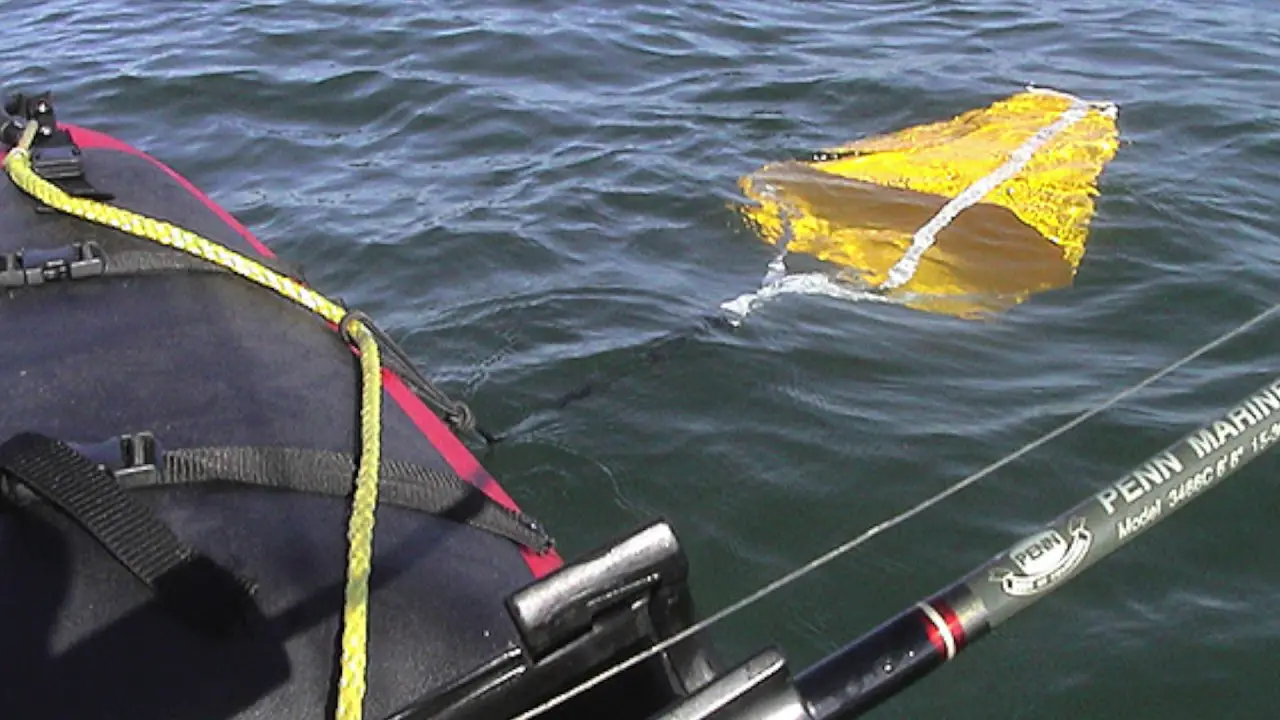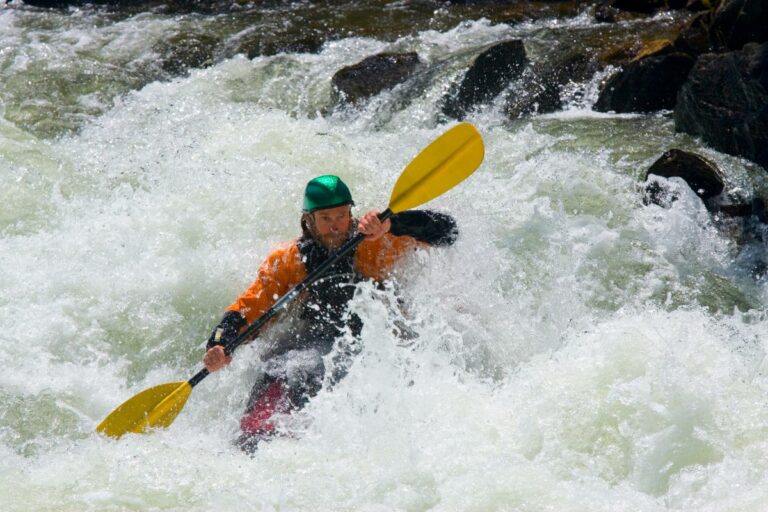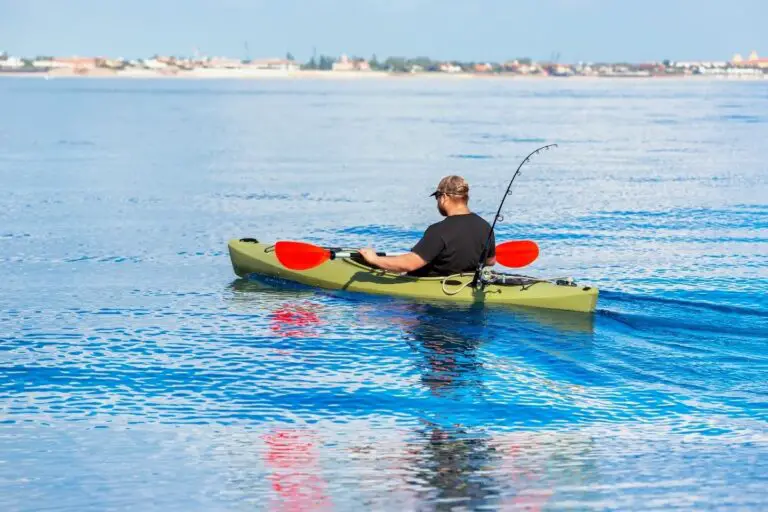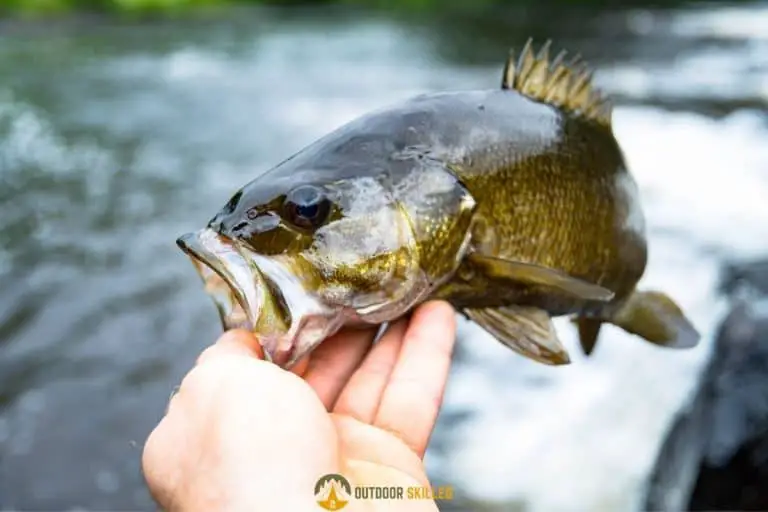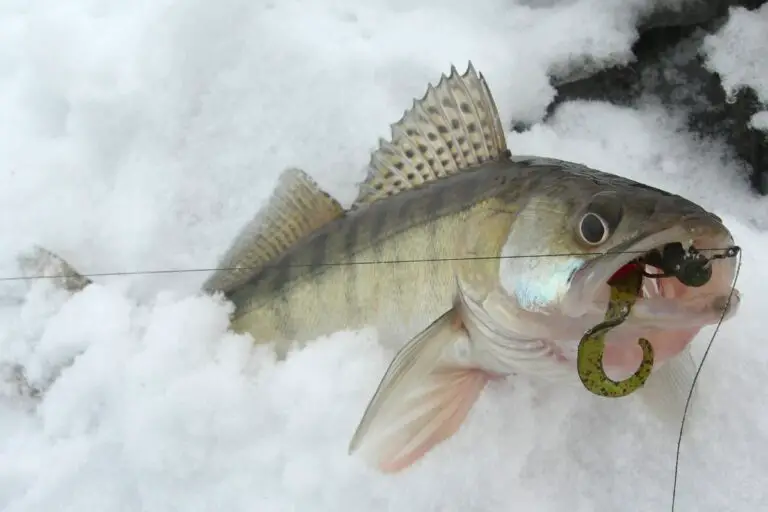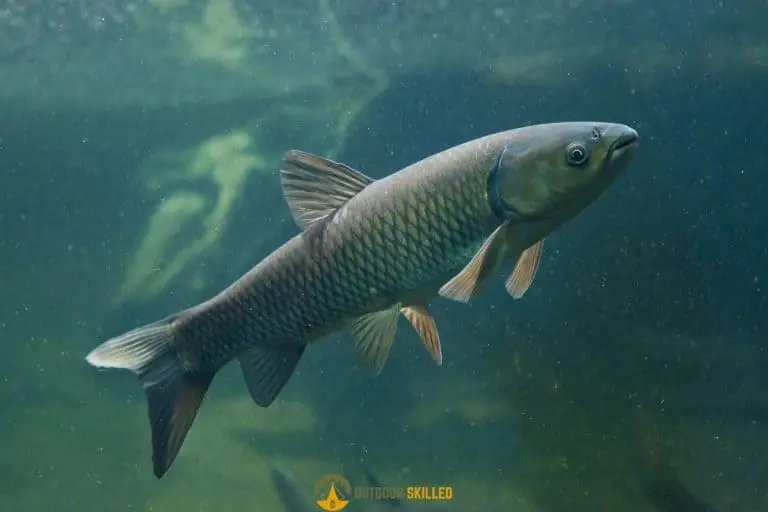What Is a Drift Sock? Do You Need It? A 2023 Guide for Everyone!
Boats, canoes, kayaks, even paddleboards are getting bigger and heavier which makes them difficult to control in any body of water, especially in harsh conditions such as strong winds or current.
No matter what size body of water you’re on if you have wind or current you need a drift sock.
So, what is a drift sock? A drift sock is a cone-shaped bag that acts as a parachute to slow down your boat or kayak in strong wind or current. Drift socks are usually made from nylon or plastic materials and they come in a kit that includes marine-grade ropes and a buoy. You can also easily fold up and store the drift sock when it’s not in use.
Continue reading to learn more about how a drift sock works, why you need it, and how to choose the right one for your vessel.
Table of Contents
How Do Drift Socks Work?
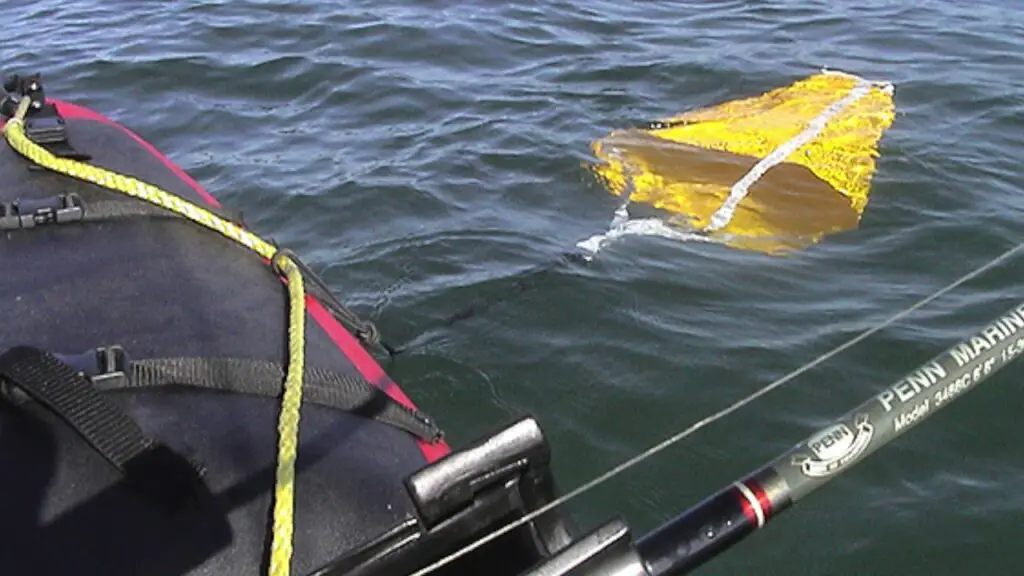
Drift socks are also known as sea anchors, drift anchors, para-anchor, or sea brakes.
They’re essentially the opposite of a sail on a sailboat. Their main function is to slow down your boat or kayak when facing strong wind or currents. They can also be used to hold your position when you’re anchored as well as control your drift speed and the direction you’re going in.
The drift sock often comes in a kit with a harness line and a buoy. The harness is attached to the drift sock on one end and to your vessel on the other end while the buoy helps keep the whole device afloat.
When the drift sock is placed in the water, the fabric bag will start to fill up and expand which creates a drag in the water that will slow down the drift of your vessel and give you more control over your speed.
The drag of the drift sock will also help keep your vessel pointing straight or moving in a certain direction depending on where you attach the drift sock to your boat.
Why Do You Need a Drift Sock?
If you’re an angler who fishes out of a boat or a kayak, you’re definitely in need of a drift sock to help you enhance your control and technique, especially when drift fishing or trolling.
Drift fishing and trolling are effective fishing techniques for targeting large gamefish species like catfish or bass. Both techniques involve using the wind to move your boat or kayak across the water while dragging your baits in the process, so you need a drift sock to be able to control the speed of your bait presentation as well as the direction you’re going in.
However, you need to be careful where you attach your drift sock and how much rope you let out as it might get caught up in your boat’s propeller when drifting or trolling. The best position to attach the drift sock is usually on the hull clip in the front of the boat and with some practice, you should be able to judge the right amount of rope you need.
Drift socks are not only used by anglers. If you’re a recreational kayaker or boater, you might still need one or two drift socks to slow down your drift in harsh conditions. This can be very useful if your motor suddenly goes out as it will help you steer away from any rocks,
Other recreational boaters also like to have 1-2 drift socks handy, just in case their motor goes out on them the drift sock will help slow their drift.
What Does a Drift Sock Kit Include?
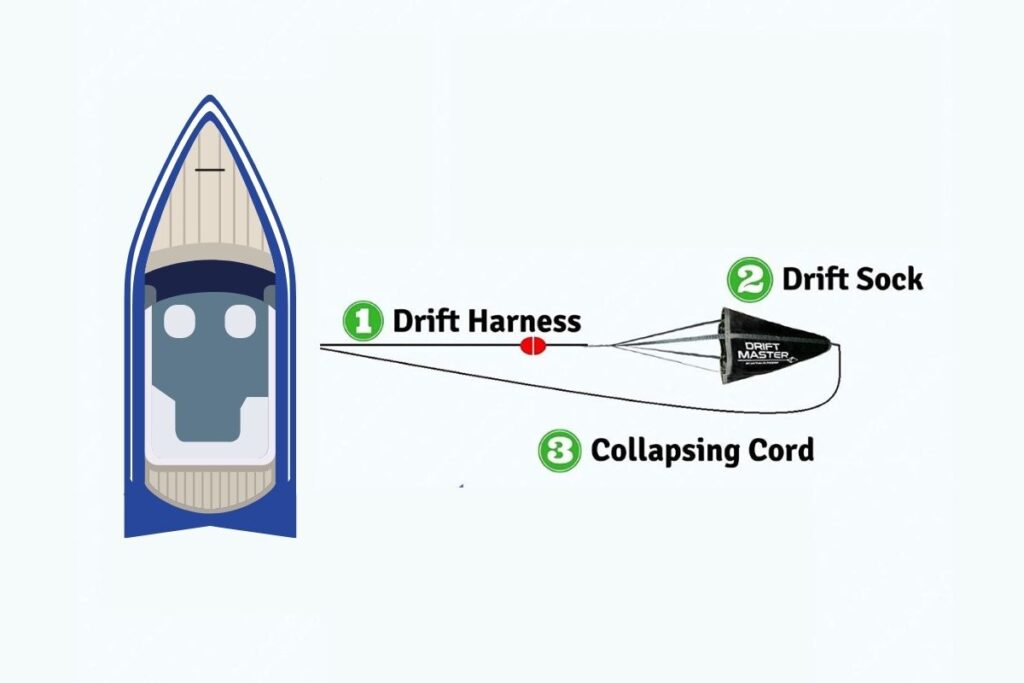
Drift socks are often purchased as a part of a kit that includes other important pieces to the system which are the harness line with a buoy, and a collapsing cord.
Let’s take a closer look at all the components of the kit and what purpose they serve.
The Harness Line and the Buoy
The harness line is a marine-grade polypropylene rope that’s at least half an inch thick and ranges between 10 and 16 feet in length.
The marine-grade properties of the rope guarantee that it will last you a long time as it’s resistant to fraying or drying out from prolonged use or exposure to UV rays
The main purpose of the harness line is to attach the drift sock to your boat or kayak as it comes with high-quality quick release clips on both ends. These clips also allow for easy removal.
The harness line also comes with a buoy that’s about 4 to 8 inches in length. The main purpose of the buoy is to ensure that the drift sock system is visible at all times. This will help enhance the performance of the drift sock and reduce any snags.
Buoys are also useful for keeping the drift sock floating on the surface of the water in case the harness line or collapsing cord gets accidentally detached from your boat or kayak.
The Drift Sock
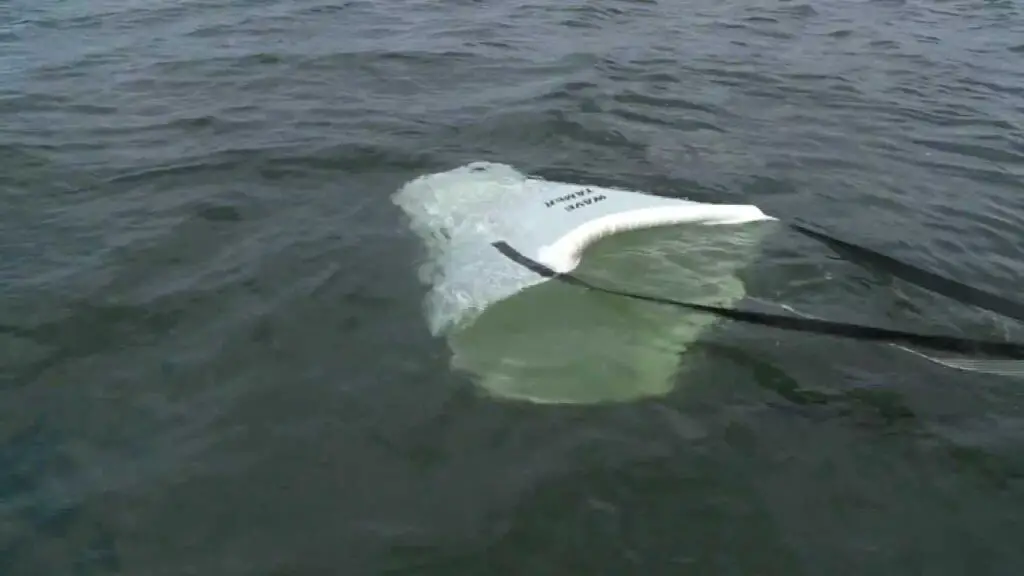
The drift sock itself is basically a bag that’s shaped like a cone and it’s the most important part of the whole system. It consists of several parts that serve different purposes.
So, let’s break down these parts from the wide-end to the narrow-end:
- The Harness Line Straps – These straps are attached to the Bucket part on one end and to the clips on the harness line on the other end. They need to be made out of durable nylon material so they won’t wear out over time.
- The Bucket – This is the wide end of the bag. It has a wide opening on one end where water will get pushed in. The quality of the bucket material can vary. It’s usually recommended to go for a drift sock that is made from heavy-duty nylon material.
- The Point – This is the narrow end of the bag. It’s closed off, so the water gets trapped in creating a drag that reduces the drift of the boat or kayak.
- The Collapsing Cord Straps – This strap is attached to the Point part on one end and to the collapsing cord on the other end. It also needs to be made out of durable nylon material so it won’t wear out over time.
The Collapsing Cord
The collapsing cord is a marine-grade polypropylene rope that’s at least half an inch thick and ranges between 15 and 20 feet in length. It’s often overlooked in importance, however, it’s an integral piece of the drift sock kit.
The main purpose of the collapsing cord is to pull in the drift sock system after you’re done using it.
Before deploying the drift sock system, you just need to attach one end of the collapsing cord to your boat or kayak while the other end will be attached to the collapsing strap on the point part of the drift sock.
It’s highly unadvised to pull in the drift sock using the harness line as this could place an extra amount of stress on the harness line that will result in tearing over time. It might also cause you to injure your back because you’ll be pulling against the water that has filled the drift sock.
How to Choose the Right Drift Sock?
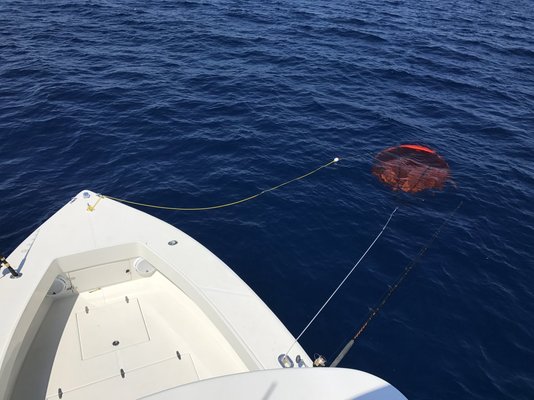
Choosing the right drift sock for your vessel has a significant impact on its durability and the efficiency of its performance.
Regardless of which drift sock kit or brand you choose, there are some important factors you need to consider such as:
- The type and size of vessel you own, whether it’s a boat, a kayak, or a canoe.
- The shape of the drift sock.
- The material the drift sock is made of and its weight.
- The material or the harness line and collapsing cord as well as the material of the quick release clips they come with
- The size and build of the buoy that comes with harness line
What Are the Different Shapes of Drift Socks?
Drift socks come in two main shapes which are cone-shaped and drogue-shaped.
The cone shape will allow the water to enter through the large opening on the bucket section and exit through the point section.
The drogue shape, on the other hand, is similar to a parachute. It has multiple openings on the sides that act as vents to allow water to exist through them.
The most popular shape for drift sock is the cone shape as it is the most effective and less prone to damage or snags.
What Kind of Material is Best for Drift Socks?
Manufacturers use different quality materials to make drift socks. The best and most popular material used to make the bucket of the drift sock and the straps is nylon.
Most manufacturers use a rip-stop or nylon material that is much similar to that of a “windbreaker” jacket. It’s durable and strong enough to withstand the weight of the water pushed into it. It’s also thin and light in weight which means it will float well and it will be easy to transport and store.
It’s best to avoid any kind of plastic materials as they’re heavier and more prone to damage.
When it comes to the harness line and collapsible cord, the best material is marine-grade polypropylene. It’s very durable and UV resistant so it will not wear out with prolonged use. Meanwhile, the preferred material for the quick-release clips is usually stainless steel.
Why Does the Size of the Drift Sock Matter?
Drift socks come in various sizes and you need to choose the right one that will best suit your needs.
The size of the drift sock you choose will depend mainly on the size of your vessel and the water conditions.
Basically, the bigger your vessel is; the more drag it will need to be slowed down in the water and the bigger your drift sock will need to be.
As for the water conditions, the stronger the wind or current is, the bigger your drift sock needs to be. You might also need to use multiple drift socks at the same time to gain more control.
Check the following chart for the most ideal size of drift socks based on the type and size of your vessel as well as the severity of the water conditions:
| Vessel Size | Light to Moderate Wind or Current | Strong Wind or Current |
|---|---|---|
| 14 feet or less (v-hull boats, canoes, or kayaks) | 33-inch drift sock | 33-inch drift sock |
| 15 – 21 feet (standard fishing boat or small pontoon boats) | 33-inch drift sock | 50+ inch drift sock |
| 22 feet or more (large fishing boats or pontoon boats) | One 50+ inch sock, or two 33-inch drift socks | Two 50+ inch drift socks |
What Are the Best Drift Socks on the Market?
There are several drift sock brands on the market with different features.
To narrow down your options, here’s a list of some of the top-rated drift socks that you can purchase from amazon along with a quick review of the features they offer and any downsides.
MOOCY 32-Inch Drogue Drift Sock

The MOOCY drift sock is one of the best drift socks when it comes to versatility and visibility.
It’s made from a durable nylon rip-stop material with reinforced webbing that will ensure it can withstand strong wind and current.
It comes with a strong harness line and a bright yellow buoy that allows the drift sock to float. It also makes it highly visible in murky water and low light conditions.
The drift sock is compact, easy to store, and it comes in a range of sizes to suit different-sized boats or kayaks.
The only downside to this product is that it doesn’t come with a collapsing cord or a storage bag, so you might need to purchase them separately.
KUFA Sports Sea Anchor Drift Sock

This drift sock from KUFA Sports is the most ideal when using the trolling fishing technique. That is because it allows you to effectively slow down your drift when you reach your target fishing spot.
It’s made from a vinyl-coated material that’s fairly durable. It’s easy to set up and quick to deploy which makes it perfect for beginners. It also comes in a range of size options to suit different-sized boats or kayaks.
There are some downsides to this product as the harness straps are not made from durable materials which can degrade over time, so it may not be the best for use in strong wind or current.
It also doesn’t come with a buoy or a storage bag, so you might need to purchase them separately.
Mythik Lures Drift Master Complete Drift Sock Kit

The Complete Drift Master kit from Mythik Lures is one of the best drift sock kits on the market. It’s suitable for use in rough water conditions as well as trolling on calm lakes, rivers, and oceans.
While it might be more expensive than other drift sock products, the high price is worth it as it includes all the accessories you need in one package.
The kit comes with a 33-inch drift sock that’s made out of reinforced rip-stop nylon. It also comes with a 16 foot UV resistant harness line with a bright buoy that will ensure that the drift sock will remain floating and visible as well as a collapsible cord that dumps excess water.
The drift sock is easy to attach to your boat or kayak and it’s quick to deploy. It also comes with a strong water-resistant bag for easy storage and transportation.
Lindy Drift Control Drift Sock

The Lindy Drift Control Drift Sock offers high durability and efficiency at a good price.
It’s made from high-density nylon material that can withstand strong winds and current. It’s easy to deploy without any snags and it comes in a range of sizes to suit different-sized boats or kayaks.
It can be easily transported as it’s extremely light in weight. This also allows it to float on the surface.
The major downside to this product is that it doesn’t come with a harness line, a collapsing cord, or a storage bag, so you might need to purchase them separately.
Cabela’s Advanced Angler Pro Series Drift Sock

The Advanced Angler Pro Series drift sock from Cabela is the most ideal for large boats.
It’s made from reinforced Oxford nylon material that enhances its durability which makes it suitable for use in strong wind and currents.
It’s designed with a built-in float on the rim bucket and it also contains a series of small weights sewn in on the pointed end. This will allow the drift sock to deploy a lot more quickly in the water.
The drift sock is relatively heavy due to its large size and built-in weights, however, it comes with a sturdy mesh bag that allows easy transportation and storage.
The only downside to this product is that it doesn’t come with a harness line or a collapsible cord, so you might need to purchase them separately.
Minn Kota Drift Sock Kit

This drift sock kit from Minn Kota is the most ideal if you’re on a budget. It offers high quality and efficiency at a very affordable price.
The kit includes a drift sock made of woven rip-stop nylon that increases its durability which makes it suitable for use in strong wind and currents.
The sock is designed with a weighted section that’s sewn in the fabric which ensures quick and easy deployment
The kit also includes a sturdy harness line with carbineer clips and a bright buoy that will ensure that the drift sock will remain floating and visible above the water surface.
The only downside to this product is that it doesn’t come with a collapsible cord or a storage bag, so you might need to purchase them separately.
How to Make a Drift Sock at Home?
Although there are various premium drift sock kits on the market, you might prefer to make your own drift sock at home to save up some of the cost.
Let’s take a look at the items you’ll need and the instructions for making your own homemade drift sock.
Items you will need
- A heavy-duty tarp sheet that’s about 8 feet long and 6 feet wide
- A marker
- Measuring tape
- A straight Edge
- Scissors
- Heavy-duty needle and thread
- 15-20 feet of Nylon rope
- A metal ring
Instructions
Step 1
Fold the tarps sheet in half so that the sides with grommets will be touching each other.
The tarp sheet should now be double layered and approximately 4 feet long by 6 feet wide.
Step 2
Determine the midpoint of the folded edge using a measuring tape. It needs to be about 36-inches from either side.
Mark the location using a marker then lay the straight edge on top of the folded tarp sheet.
Line up one end of the straight edge with the marked midpoint, while the other end is at a corner on the opposite side of the tarp sheet then trace alongside the straight edge using the marker.
Repeat the same process on the other side, so now you’ll have a marked triangle.
Cut along both lines using scissors and make sure you’re cutting through both layers of the tarp sheet.
Step 3
Sew both layers of the left and right sides together using the heavy-duty needle and thread. Make sure to leave the side near the grommets open
Repeat the process so that both seams are double-stitched. The tarp sheet should now be shaped like a cone.
Step 4
Cut the nylon rope into four pieces, each piece should be about 3 feet long.
Tie each rope piece to one of the grommets then tie the other end of each rope piece to the metal ring.
Tie one end of the remaining length of rope to the metal ring and the other end will be attached to your vessel.
Make sure to attach a float or buoy to the rope on the side of the metal ring that’s tied to the vessel. This will prevent your drift sock from sinking to the bottom if it gets detached from your vessel.
Want something more visual? Here is a simple video showing how to make a drift sock at home:
This was made for walleye fishing, but it is a good way to do any drift sock and you can modify it as you want. You can also learn about how to catch more walleye in this post on the best powerbait for walleye.
How to Install a Drift Sock System to Your Vessel?
Whether you’re using a store-bought or a homemade drift sock, attaching it to your vessel is a very simple process.
Here are the steps you need to follow:
Step 1 – Choose a location on your vessel where you’ll attach one end of the harness line.
You need to choose a cleat with a hole that’s big enough to tie or clip the harness line onto.
The easiest and most common location to attach your drift sock harness is at the rear of your vessel.
If you’re using a kayak with an anchor trolley, it will much easier to change the location of your drift sock according to your preference.
Step 2 – Attach the other end of the harness line to the harness straps that are located on the drift sock.
Step 3 – Attach one end of the collapsing cord to your vessel or to the clips on the harness line.
Step 4 – Attach the other end of the collapsing cord to the collapsing strap that’s located on the pointed end of the drift sock.
Step 5 – Place the drift sock in the water and allow it to expand as it fills up with water.
Step 6 – You can let out as much or as little amount of the harness line as you want depending on your conditions.
It’s usually recommended to let out the drift sock at approximately 6-10 feet while making sure that the buoy is closer to the drift sock
How to Use a Drift Sock When Fishing?
The way you set up your drift sock on your boat or kayak has a significant impact on your fishing technique.
When drift fishing from the side of the boat using a single drift sock, it’s recommended to position the sock in the middle or front portion of the boat.
When trolling using a drift sock, you first need to determine the location of the fish you’re going to target then continue past that spot in the direction of the wind.
The distance you need to go past the spot depends on several factors such as the speed of the wind or current, the size of your boat or kayak, and the type of lure you are using.
If the wind or current is really strong, your boat or kayak will get pushed over the target spot faster, so it’s best to position your vessel farther back. This will give you enough time to deploy the drift sock and for it to inflate and slow down your drift.
Make sure to drop all the lures and baits you want to use in the water before you deploy your drift sock. This will allow the lures and baits to remain longer in the strike zone which increases your chances of catching more fish.
Here are two other methods you can use your drift sock to slow down your vessel:
Forward Stroll
This is one of the easiest methods to set up your drift sock and it will help slow down your boat or kayak while you’re moving forward.
All you need to do is attach your drift sock system to the stern of your boat or kayak while Keeping in mind that the wind needs to be at your back. If you have a trolling motor in the front you can use it to steer the bow to the left or to right.
Sideways Drift
This method will allow you to turn your boat or kayak in a direction that’s perpendicular to the wind.
You will need to use two drift socks for this. One will be attached near the bow of the vessel while the other will be attached at the stern.
For the bow, it’s recommended to use a 33-inch drift. For the stern, on the other hand, it’s recommended to use either a 30-inch drift sock if your vessel is small or a 50+ inch drift sock if your vessel is big. You also can check the sizing chart mentioned before for the most ideal drift sock size according to the size of your vessel.
Pro Tips When Using a Drift Sock
Here are some pro tips that might be useful when using a drift sock whether it is for fishing or recreational purposes:
- If the wind and currents are too strong, try to let out as much of the rope as you can to improve your control.
- Drift socks normally perform the best when the line is attached parallel to the water.
- It’s not recommended to drift sideways when the wind and current are too strong as this could cause lead to ripping the cleat off your vessel or even capsizing.
- If you’re going to reposition the cleats on your vessel, try to place them a few inches behind the trolling motor. This way the drift sock will not get in the way of the motor when you’re raising or deploying it.
- Attaching your drift sock to the rear corner of your vessel will allow your electronics to perform better as it will be out of the way
- Avoid using ordinary rope to attach your drift sock to your vessel as it might be torn off due to extremely strong wind or current and you’ll end up losing your drift sock. It’s best to use propylene rope or any rope made of marine-grade material.
How to Maintain Your Drift Sock System?
You need to maintain your drift sock system to make it last longer. You can do this by detaching the drift sock from your boat or kayak after you’re done using it, then storing it separately in a protective water-resistant bag away from extreme heat or moisture.
To clean your drift sock, you need to soak it in warm water with a small amount of soap or detergent and avoid using any bleaching substances. You can gently scrub the drift sock using a soft brush. Avoid using a harsh brush, especially if the drift sock is made from nylon material, as this might scratch up the material.
Finally, make sure to thoroughly dry the drift sock before storing it to avoid causing permanent damage to the material.
Other Devices You Can Use to Improve Your Control Over Your Vessel
There are some other devices you can install that will help you gain more control over your boat or kayak when facing rough wind and current.
Let’s take a look at some of these devices:
Rudders and Skegs
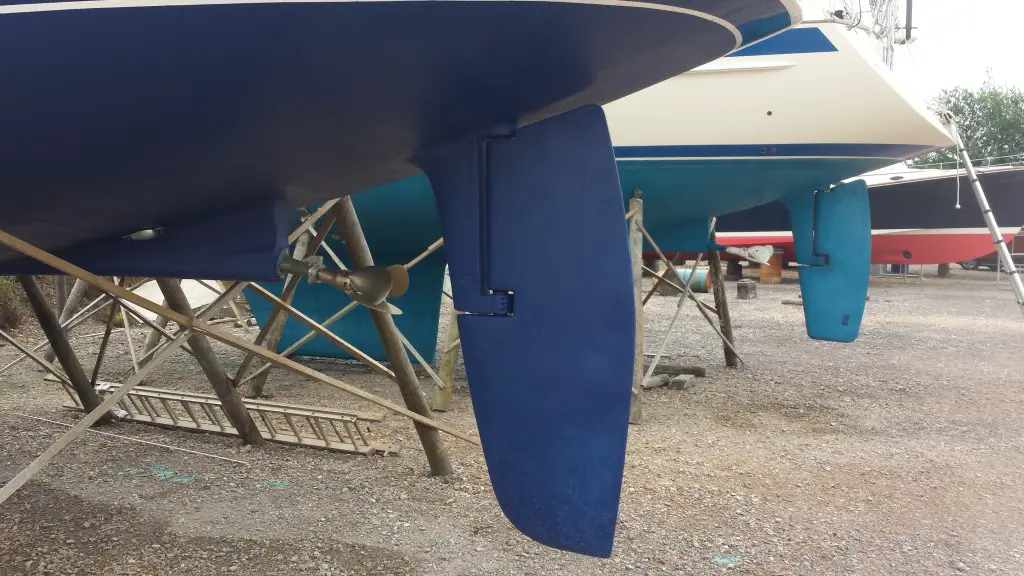
A rudder is an adjustable fin that drops down the back of your vessel while a skeg extends and retracts from the bottom of the kayak.
Both devices are used to help gain more control over your vessel and to counteract different factors that might cause it to go off course.
You can use a rudder or a skeg when there are rough winds pushing your vessel from the rear making it hard to control. You can also use them when a strong current is coming at one side of the vessel making it hard to keep tracking in a straight line.
Anchor Trolley
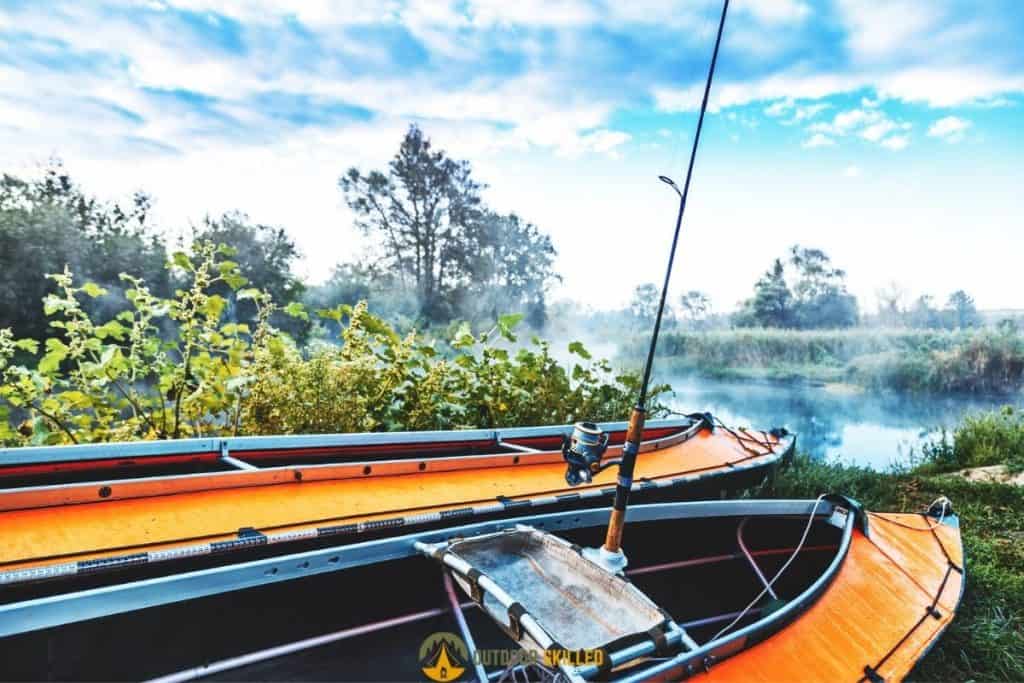
An anchor trolley is a mechanism that’s attached to the side of your vessel.
Its main function is to change the position of your vessel by changing the position of your anchor without having to get out of the vessel or taking your anchor out of the water.
This will help you quickly and easily adapt to any changes in current or wind while you’re out on the water.
The mechanism consists of 3 main parts – pulleys, a rope, and a ring. The anchor line is attached to the ring. By pulling on the rope, the ring will move forward and backward along the length of your vessel and you’ll be able to adjust the point where your anchor line is attached to your vessel thereby changing the anchor position according to your liking.
Stake-Out Poles
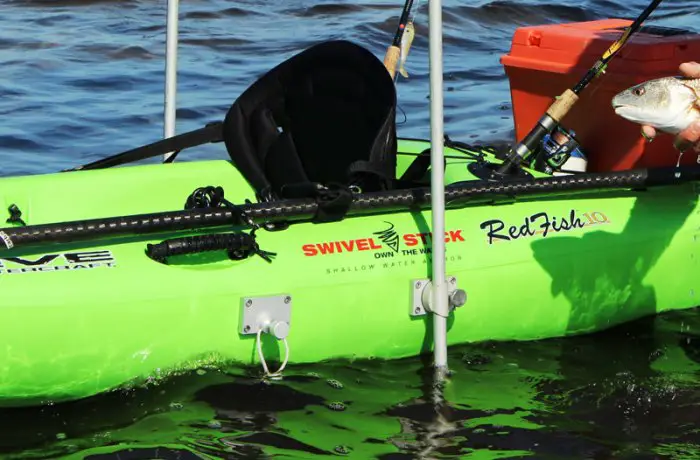
A stake-out pole is a long pole that’s usually made of fiberglass. You can stick the pole into the bottom of the water to anchor your vessel and keep it in a certain position.
All you need to do is push down the pole firmly into the bottom of the water and tie it to your anchor cleat. If you have a kayak, you can stick the pole down through a scupper hole.
It comes in lengths less than 12 feet, so they’re most suitable for shallow flat-waters like lake margins, canals, or backwaters. It also works best in soft sandy bottoms that the pole can easily sink down into.
Related Questions
Can Drift Socks Sink?
Drift socks can sink if they’re not attached to any floating devices as they can be made from heavy materials. That’s why the drift sock kit usually includes a buoy attached to the harness line which helps keep your drift sock system floating above the water surface.
What to do If the Drift Sock Got Stuck?
Your drift sock might get stuck after it snags on any kind of submerged structure especially. All you need to do is backtrack with your boat or kayak slowly until you’re slightly behind the location where the drift sock is stuck, then start pulling gently on the collapsing cord until the drift sock comes off the snag.
Can You Fix a Ripped Drift Sock?
You can fix some small rips in your drift sock by patching it using heavy tarp sheets and sewing them using a heavy-duty needle and thread. However, if the rips are too big to be patched up or sewn shut, it might be a better idea to replace your drift sock with a new one.
Do You Need to Use a Drift Sock When There’s No Wind or Current?
You do not need to use a drift sock when there’s no wind or current. It’s better to pack it up and store the drift sock when it’s not in use to avoid getting it snagged or torn. Make sure to store the drift sock in a water-resistant bag to protect it from extreme heat or moisture.
Can A Drift Sock Be Used to Completely Stop a Moving Boat?
A drift sock cannot be used to completely stop a moving boat. Instead, it’s mainly used to slow down your drift when facing strong wind or current. However, if you’d like to completely stop your boat from moving, you can always use a standard fishing anchor.
What’s the Standard Method to Anchor Your Boat or Kayak?
The standard method of anchoring your boat or kayak is by using a fishing anchor such as folding grapnel anchors, claw anchors, or mud anchors. These anchors are available in a wide range of shapes and sizes. Choosing the right kind of anchor for your vessel will depend mainly on the kind of water bottom you will be boating in.
How Much Rope Do You Need When Anchoring a Vessel?
In general, you need your anchoring rope to be twice as long as the depth of the water. So, if you are going to anchor your vessel in 10 feet of water, you will need to let out 20 feet of rope. Letting more of the rope out will allow the anchor to drag and effectively catch the bottom thereby stopping your vessel from moving.
Helpful Resources
Kayak your way to Freedom
- On a budget? Check out the best fishing kayaks under $500 here and the best Fishing Kayaks under $1,000 here. Or Check the best Cheap Kayaks here.
- Going fishing? Here are the best Ocean fishing kayaks, and here are the best River Fishing Kayaks.
- You can also find the best Fly Fishing Kayaks here and the best Bass Fishing Boats here.
- A bit experienced? Check out the best modular kayaks here and the best tandem fishing kayaks here.
- Looking for something special? Check out my favorite Ducky kayaks here.
- Navigate your way with these awesome and beginner-friendly Kayak compasses.
- Going Hunting? These Duck hunting kayaks will give you an unfair advantage!
- Have a need for speed? These motorized kayaks will get you moving.
- Protect yourself from the sun with these Kayak shades, and make your kayak more comfortable with these Kayak seats.
- Keep your feet dry and warm with these superb Kayaking shoes.
- Going Kayaking in cold water? Stay warm with these Kayaking gloves.
- Paddle Less, Fish More with the Best Kayak Motors
- Looking to get a trolling motor on your kayak? Check out the best kayak trolling motor mounts here.
If you like this article, please share it or pin it, you can find the share buttons below. We will really appreciate it ❤️

